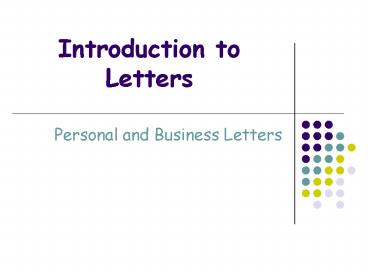Introduction to Letters - PowerPoint PPT Presentation
1 / 18
Title:
Introduction to Letters
Description:
Personal and Business Letters ... Write a LETTER OF COMPLAINT to the Manager in Full-Block Style. Remember this is a business letter not a personal letter. – PowerPoint PPT presentation
Number of Views:153
Avg rating:3.0/5.0
Title: Introduction to Letters
1
Introduction to Letters
- Personal and Business Letters
2
Business to Business Letter
- Written from one business to another. Some
reasons include - To thank a business for a job well done
- To request supplies
- To order products or services
- Etc.
3
Personal Business Letters
- This type is sent from an individual to a
business. Some of the reasons include - To thank a business for great customer service
- To inquire more information
- To file a complaint
- To apply for a job (cover letter)
- Etc.
4
Parts of a Business Letter
5
Heading/Sender's Address
- The sender's address usually is included in
letterhead. - If you are not using letterhead, include the
sender's address at the top of the letter one
line above the date. - Do not write the sender's name or title, as it is
included in the letter's closing. Include only
the street address, city, and zip code.
6
Date
- The date line is used to indicate the date the
letter was written. - However, if your letter is completed over a
number of days, use the date it was finished in
the date line.
7
Inside Address
- The inside address is the recipient's address.
- It is always best to write to a specific
individual at the firm to which you are writing.
If you do not have the person's name, do some
research by calling the company or speaking with
employees from the company. - Include a personal title such as Ms., Mrs., Mr.,
or Dr. Follow a woman's preference in being
addressed as Miss, Mrs., or Ms. If you are unsure
of a woman's preference in being addressed, use
Ms. - The inside address begins one line below the
sender's address or one inch below the date. It
should be left justified, no matter which format
you are using.
8
Salutation
- Use the same name as the inside address,
including the personal title. If you know the
person and typically address them by their first
name, it is acceptable to use only the first name
in the salutation (for example Dear Lucy). - In all other cases, however, use the personal
title and full name followed by a colon. Leave
one line blank after the salutation. - If you don't know a reader's gender, use a
nonsexist salutation, such as "To Whom It May
Concern." - It is also acceptable to use the full name in a
salutation if you cannot determine gender. For
example, you might write Dear Chris Harmon if
you were unsure of Chris's gender.
9
Body
- For block and modified block formats, single
space and left justify each paragraph within the
body of the letter. - Leave a blank line between each paragraph.
- In the first paragraph, consider a friendly
opening and then a statement of the main point. - The next paragraph should begin justifying the
importance of the main point. - In the next few paragraphs, continue
justification with background information and
supporting details. - The closing paragraph should restate the purpose
of the letter and, in some cases, request some
type of action.
10
Closing
- The closing begins at the same horizontal point
as your date and one line after the last body
paragraph. - Capitalize the first word only (for example
Thank you) and leave four lines between the
closing and the sender's name for a signature. - If a colon follows the salutation, a comma should
follow the closing otherwise, there is no
punctuation after the closing.
11
LineSpacing
12
A note about format and font
13
Block Format
- The most common layout of a business letter is
known as block format. - Using this format, the entire letter is left
justified and single spaced except for a double
space between paragraphs.
14
Modified Block
- Another widely utilized format is known as
modified block format. - In this type, the body of the letter and the
sender's and recipient's addresses are left
justified and single-spaced. - However, for the date and closing, tab to the
center point and begin to type.
15
Semi-Block
- The final, and least used, style is semi-block.
- It is much like the modified block style except
that each paragraph is indented instead of left
justified.
16
Font
- Another important factor in the readability of a
letter is the font. - The generally accepted font is Times New Roman,
size 12, although other fonts such as Arial may
be used. - When choosing a font, always consider your
audience.
17
Punctuation
- Punctuation after the salutation and closing -
use a colon () after the salutation (never a
comma) and a comma (,) after the closing.
18
Letter Writing Assignment 1
- Think of a bad situation that happened to you
while you were eating at a restaurant. - Write a LETTER OF COMPLAINT to the Manager in
Full-Block Style. - Remember this is a business letter not a personal
letter. - Use the real-business address of the person you
are writing to and an address where you can be
reached. - Be sure to include three paragraphs in the body
of your letter. Have your letter proof-read by a
classmate before you submit your final copy!!!!































